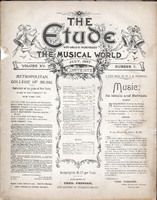Selected Content from the July 1897 Edition of The Etude
Usefulness Of Some Recent Composition. BY JAROSLAW DE ZIELINSKI. A Flemish musician, Jerome de Cockx, once visited Martin Luther, and was astonished, on his introduction to the great reformer, at seeing on the table a flute and a guitar. “Here,”… Read More
It is much easier to raise the charge of plagiarism than to substantiate it. For are we not all plagiarists in our sayings and doings? Do we not, through early education and association, through reading, nay, through the visible example of our elders, imbibe ideas which we do not hesitate to express as our own? Do we not unconsciously reflect the opinion of our daily paper, whether in politics, sporting matters, the drama, art, or music,—little thinking that we are mere plagiarists of an editor who, in turn, may be plagiarizing some one else? Read More
E. M. Sefton was born in Benton County, Iowa, on the ninth of October, 1859. Love of music was early manifested in him, as he commenced its study when thirteen years of age. During the progress of his musical education… Read More
Madame Pupin is a native of New Jersey. She inherited her musical talent from her father, who was a natural musician, playing several wind and string instruments though he had never taken a lesson in his life. The father also… Read More
Miss Julia B. Chapman was born in Brooklyn, N. Y., but has spent the greater portion of her life in the South. She received her musical education from eminent teachers in New Orleans. For the past eight years Miss Chapman… Read More
Editor of the Vocal Department:— Dear Sir.—It is with much interest and pleasure that I have read the article in the May Etude regarding development of the so-called ”falsetto ” voice, and heartily agree with every point excepting the statement… Read More
There have been teachers of the art of singing whose sole aim was effect,—who were inspired by this baser construction put upon the art value. True vocal art invariably has a within and a without point of view. The within… Read More
BY H. LORAN CLEMENTS. Modern education in a sense is a system of self development and instruction. The wide-awake student of today will not take every statement of his text-book or instructor on faith, but will only be satisfied when… Read More
Blind Tom, once so prominent a figure on the concert stage, is now described as a “tall, broad shouldered, neatly dressed colored man, whose gray hair and sightless eyes increase the impressiveness of his appearance.” …. In the south walk of the old cloisters of Westminster Abbey in London there is an old, simple gravestone, lying flat on the ground, bearing this inscription: “Muzio Clementi, called the Father of the Pianoforte; his fame as a musician and composer, acknowledged throughout Europe, procured him the honor of a public interment in this cloister. Born at Rome, 1752. Died at Evesham, 1832.” Thus runs the world away. The best man living, let him die to day, to-morrow may be forgotten, and his tombstone be cracked and covered with moss. Read More
2. If this means to convert tone vibrations into color vibrations by increased rapidity, there is no known way of doing it. Tones are propagated by waves of air; but light is believed to travel along waves of ether. Perhaps our correspondent refers to the sympathetic action of light upon tone as shown by the photophone. This is a circular disk with slots around the edge. A ray of light is directed through one of these holes, and as the disk is turned the ray passes successively through each hole, beating rapidly upon a glass tube filled with some substance or other. Presently the tube gives forth a musical tone, more or less resonant according to the material used. Read More
Notices for this column inserted at 3 cents a word for one insertion, payable in advance. Copy must be received by the 20th of the previous month to insure publication in the next number. WANTED.—A LADY WITH SEVERAL YEARS’successful… Read More




